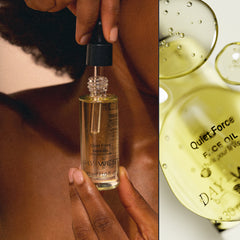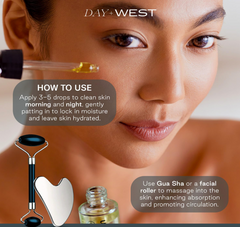At Day+West (dayandwest.com), we believe in beauty that begins within. In creating our Quiet Force® face oil, we looked to both history and science, drawing on time-honored rituals and modern research to craft something truly intentional. Our formulas highlight powerhouse ingredients like squalane, rosehip oil, and jojoba, each chosen for their deep roots in traditional beauty practices and proven results in modern skincare.
Long before serums and ampoules lined our vanities, face oils were the backbone of beauty rituals across civilizations. They soothed sunburns in the deserts of Egypt, graced the marble counters of Roman baths, and shimmered beneath powder on the faces of Hollywood starlets. As beauty trends come and go, face oil has remained, treasured for its nourishment, elegance, and ancestral wisdom.
Sacred Oils of the Nile
The ancient Egyptians were innovators in skin care alongside medicine and astronomy. Oils were more than cosmetic: they were spiritual protection, essential to both daily rituals and the afterlife.
Cleopatra, one of the most mythologized beauty icons in history, is said to have anointed her skin with moringa, castor, and sesame oils, which protected her against sun damage and dryness caused by the harsh desert climate. These potent, multipurpose elixirs were believed to preserve youth and even ward off illness.
Frankincense and myrrh, both used in embalming, doubled as anti-inflammatory skin treatments. The elite would apply these oils after bathing to tone, moisturize, and scent the body, maintaining supple skin for days.
The Original Spa Experience
In Ancient Greece, olive oil was revered as a symbol of vitality, used in both athletics and aesthetics. Athletes anointed their bodies before competitions to highlight muscles, while physicians like Hippocrates prescribed oils for therapeutic healing.
In Rome, public bathhouses were epicenters of grooming. Citizens would massage their bodies with olive, almond, or hazelnut oil before scraping it off with a curved metal tool called a strigil - a precursor to modern exfoliation. Wealthier households would scent the oils with perfumes before bathing, elevating baths to aromatic, multi-sensory experiences.
The European Fountain of Youth
While the Middle Ages saw a decline in elaborate beauty practices in Europe, face oils remained in use among the aristocracy, often tied to spiritual purity. Rose oil, distilled through early Arab techniques, became a coveted luxury among noblewomen for its calming scent and complexion-enhancing properties.
By the Renaissance, skincare flourished again. Italian and French courts embraced neroli oil, prized for its anti-aging properties and divine fragrance. Wealthy women of Venice were renowned for their glowing skin, often achieved through strategic oil application beneath lead-based cosmetics. The result: an ethereal, luminous complexion that became a signature of the era.
Hollywood’s Golden Glow
By the 1920s, facial oils were refined for the silver screen. The Golden Age of Hollywood demanded skin that gleamed under studio lights, leading to sophisticated skincare regimens that would influence beauty standards for generations.
Marilyn Monroe, still revered as a beauty icon today, reportedly used oils prescribed by Dr. Erno Laszlo, her dermatologist. She also famously applied Vaseline under her foundation to create a diffused, candlelit effect, an early form of today’s “slugging trend”.
Rita Hayworth was known for applying olive oil to her hair, wrapping it in a towel for deep conditioning, then rinsing it with lemon juice to restore shine. Her lustrous tresses became her trademark, proving that oils weren’t just for faces.
Sophia Loren reportedly credited olive oil treatments with maintaining her radiant skin well into her later years. The Mediterranean starlet embraced natural oils over harsh chemicals, embodying clean beauty long before the term existed.
Hollywood dermatologists knew the camera demanded perfection, and oils provided the healthy glow that makeup alone couldn’t achieve.
Modern Formulas, Ancient Roots
Today’s face oils reflect the same foundational wisdom, bolstered by cosmetic science and clean beauty ethics. Argan oil, used for centuries by Berber women in Morocco, is now a staple in anti-aging blends. Rosehip oil, a cult favorite among skincare enthusiasts, delivers vitamin C and linoleic acid for cellular regeneration, which is why we’ve made it a cornerstone ingredient in our formula.
Squalane, once derived from shark liver, is now sustainably produced from olives or sugarcane. Its lightweight texture makes it ideal for all complexion types, delivering long-lasting hydration while reinforcing the skin’s natural defenses against environmental stressors.
Jojoba oil, technically a liquid wax, has been used by indigenous communities in the American Southwest for centuries to heal and protect. Its molecular structure closely resembles human sebum, making it one of the most skin-compatible oils available, helping to regulate sebum production, calm inflammation, and support a healthy moisture barrier without overwhelming delicate skin.
What began as a sacred ritual in ancient temples and bathhouses now lives in every drop of facial oil on a modern shelf. Whether massaging it into your complexion before bed or adding a few drops to your morning routine, you’re part of a lineage that spans millennia.
At Day+West, we honor that lineage with reverence. Every bottle of our Quiet Force® is a modern heirloom, crafted with ingredients like rosehip oil, squalane, and jojoba to soothe, restore, and reconnect you with what’s always been essential. It’s a product of care, craftsmanship, and deep respect for the traditions that came before us.


